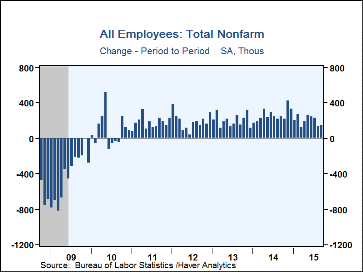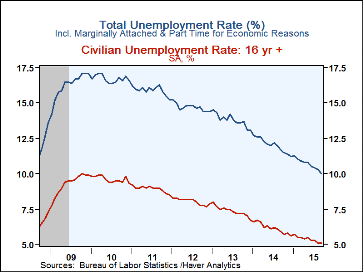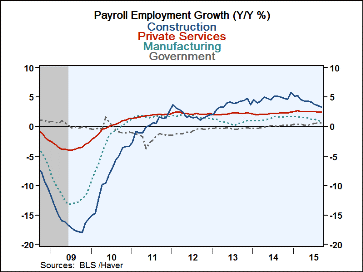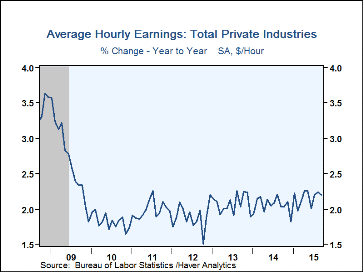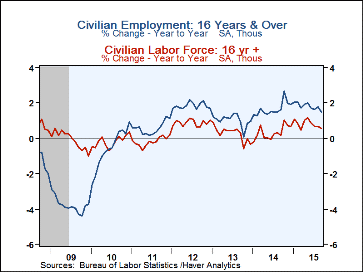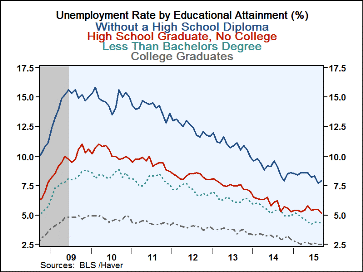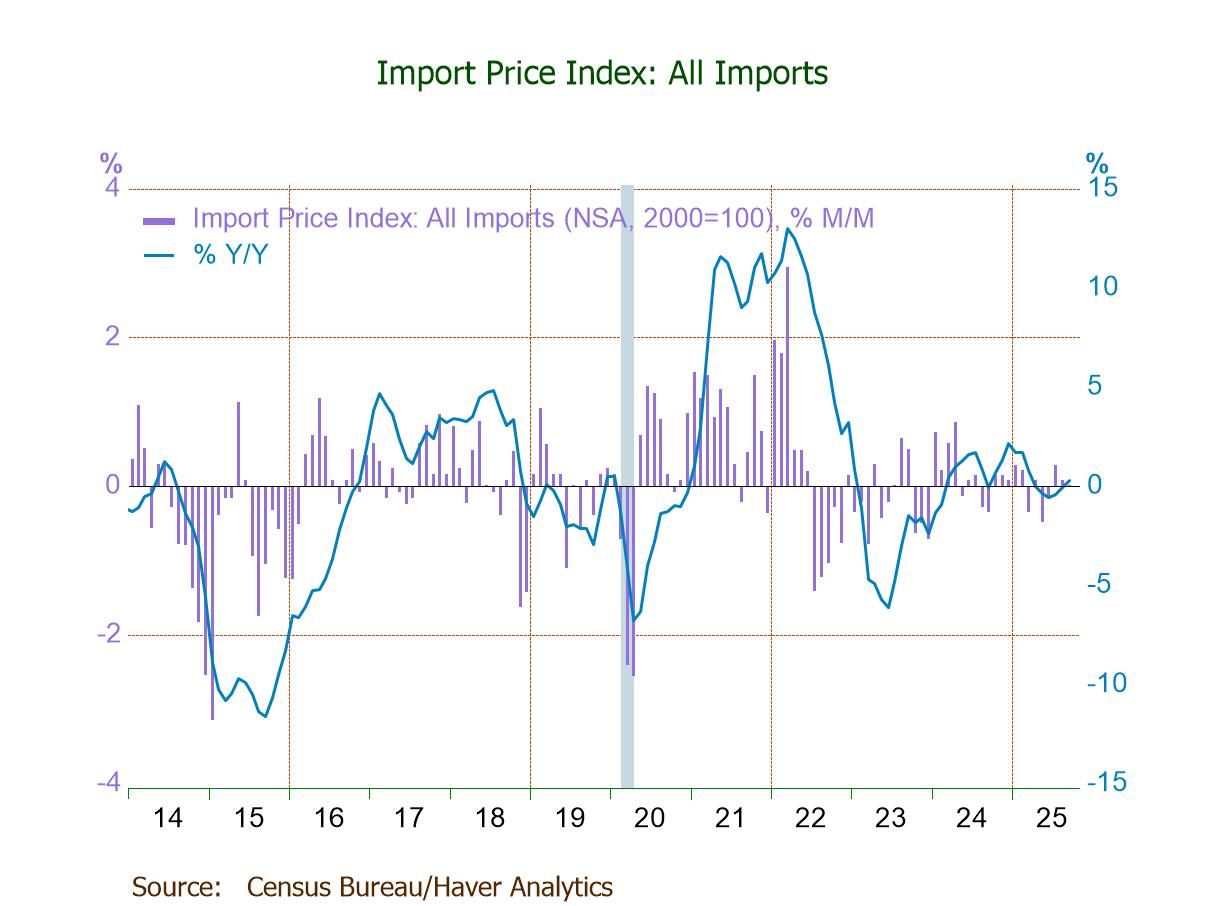 Global| Oct 02 2015
Global| Oct 02 2015U.S. Payroll Gain Disappoints Again; Earnings Stabilize Along With Jobless Rate
by:Tom Moeller
|in:Economy in Brief
Summary
Job growth remained weak for a second month during September. Nonfarm payrolls grew 142,000 following downwardly revised increases of 136,000 and 223,000 during the prior two months. The gains compared to a 260,000 average last year [...]
Job growth remained weak for a second month during September. Nonfarm payrolls grew 142,000 following downwardly revised increases of 136,000 and 223,000 during the prior two months. The gains compared to a 260,000 average last year and the latest disappointed expectations for a 200,000 rise in the Action Economics Forecast Survey. Weakness centered in the factory and private services industries. Lessened job growth brought with it an unchanged level of average hourly earnings. The unemployment rate also remained unchanged at an expected 5.1%, though the total jobless rate dipped to 10.3%.
From the payroll employment survey, the 142,000 rise in payrolls reflected a decline of 9,000 in manufacturing payrolls, which followed an 18,000 August drop. These were the first negative readings since mid-2013. Construction employment rose 8,000 which was improved from the prior two months gains, but still was well below the double-digit increases dating back through 2013. Mining employment fell another 10,300 (-11.7% y/y), continuing its year-long slide.
Private service sector employment also was weak with its 131,000 rise, down from gains closer to 250,000 at the beginning of the year. Wholesale employment declined 4,000 (+1.2% y/y). Financial activities jobs remained unchanged (1.8% y/y) while educational services employment fell 7,900 (+0.2% y/y). The 31,000 rise (3.2% y/y) in professional & business services employment was roughly half the monthly gains during Q2. Temporary employment rose a modest 4,600 (3.7% y/y) and transportation & warehousing employment improved a negligible 3,500 (3.0% y/y). Modest retail trade job growth of 23,700 (2.0% y/y) followed a minimal 4,400 gain in August. Heath care employment rose 34,400 (3.2% y/y), the weakest gain in four months. Job growth in leisure & hospitality held fairly steady at a firm 35,000 (2.9% y/y). Government payrolls increased 24,000 (0.7% y/y), somewhat less than the gains during the prior three months. Federal government jobs fell 2,000 (+0.3% y/y) but state government jobs improved 17,000 (1.0% y/y), up from little or no growth during the prior nine months. Local government jobs rose 9,000 (0.6% y/y) compared to gains of more than double that in the prior three months.
The length of the average workweek eased to 34.5 hours from 35.6 during the prior two months. The factory sector workweek shortened significantly to 40.6 hours versus 41.0 averaged in Q4. The construction workweek also fell sharply to 38.5 hours versus a February high of 39.5. The private services workweek held steady at 33.4 hours for the fifth straight month. Hours in the financial sector remained at a record 37.7 for the fifth straight month.
Aggregate hours worked (employment times hours) fell 0.2% (+2.3% y/y) leaving the Q3 gain at 2.7%, the strongest rise this year. During the last ten years, there has been a 67% correlation between the change in hours worked and growth in real GDP.
Average hourly earnings remained unchanged, though the August increase was raised to 0.4% from 0.3%. Expectations had been for a 0.2% rise. September's earnings figure was the weakest figure since a slight decline in December. It left the three-month change stable at 2.3% (AR). Earnings were unchanged across most industries though they fell 0.5% (+1.9% y/y) in construction.
From the household employment survey, unemployment rate stability at 5.1% reflected a 236,000 decline (+1.5% y/y) in employment accompanied by a 350,000 drop (+0.6% y/y) in the labor force. The labor force participation rate declined to 62.4%, the lowest level since October 1977. Growth in the number of workers not in the labor force of 2.2% y/y was slightly below the growth of the last several years.
The average duration of unemployment nudged up m/m to 28.4 weeks, but was down from 39.4 weeks in 2011 and 2012. Seventeen percent of workers were out of work for 52 weeks or longer compared to 31.4% in 2011.
The unemployment rate amongst those without a high school diploma was 7.7%, while for high school graduates with no college it was 5.5%. For those with some college or an associates degree, it was 4.4% and for college graduates, the jobless rate was 2.5%.
The labor market data is contained Haver's USECON database. Detailed figures are in the EMPL and LABOR databases. The expectations figure is in the AS1REPNA database.
| Employment: (SA M/M Change, 000s) | Sep | Aug | Jul | Y/Y | 2014 | 2013 | 2012 |
|---|---|---|---|---|---|---|---|
| Payroll Employment | 142 | 136 | 223 | 1.9% | 1.9% | 1.7% | 1.7% |
| Previous | -- | 173 | 245 | -- | -- | -- | -- |
| Manufacturing | -9 | -18 | 11 | 0.7 | 1.4 | 0.8 | 1.7 |
| Construction | 8 | 5 | 5 | 3.1 | 4.8 | 3.7 | 2.1 |
| Private Service Producing | 131 | 122 | 188 | 2.4 | 2.2 | 2.2 | 2.2 |
| Government | 24 | 36 | 28 | 0.8 | 0.0 | -0.3 | -0.8 |
| Average Weekly Hours - Private Sector | 34.5 | 34.6 | 34.6 | 34.5 (Sep.'14) |
34.5 | 34.5 | 34.4 |
| Private Sector Average Hourly Earnings (%) | -0.0 | 0.4 | 0.2 | 2.2 | 2.1 | 2.1 | 1.9 |
| Unemployment Rate (%) | 5.1 | 5.1 | 5.3 | 5.9 (Sep.'14) |
6.1 | 7.4 | 8.1 |
Tom Moeller
AuthorMore in Author Profile »Prior to joining Haver Analytics in 2000, Mr. Moeller worked as the Economist at Chancellor Capital Management from 1985 to 1999. There, he developed comprehensive economic forecasts and interpreted economic data for equity and fixed income portfolio managers. Also at Chancellor, Mr. Moeller worked as an equity analyst and was responsible for researching and rating companies in the economically sensitive automobile and housing industries for investment in Chancellor’s equity portfolio. Prior to joining Chancellor, Mr. Moeller was an Economist at Citibank from 1979 to 1984. He also analyzed pricing behavior in the metals industry for the Council on Wage and Price Stability in Washington, D.C. In 1999, Mr. Moeller received the award for most accurate forecast from the Forecasters' Club of New York. From 1990 to 1992 he was President of the New York Association for Business Economists. Mr. Moeller earned an M.B.A. in Finance from Fordham University, where he graduated in 1987. He holds a Bachelor of Arts in Economics from George Washington University.


